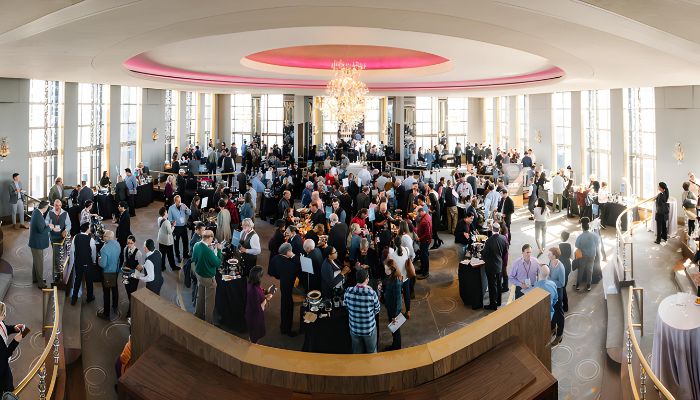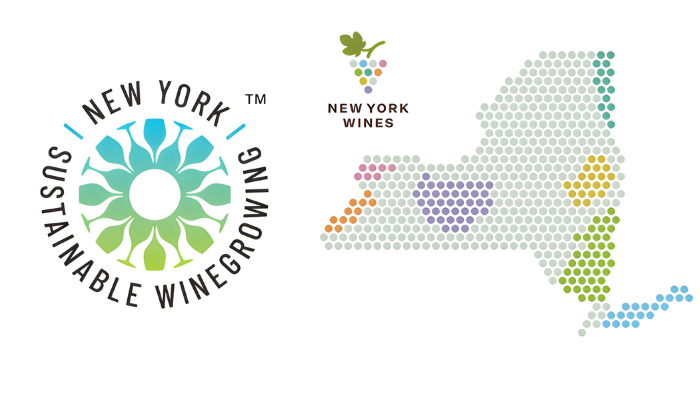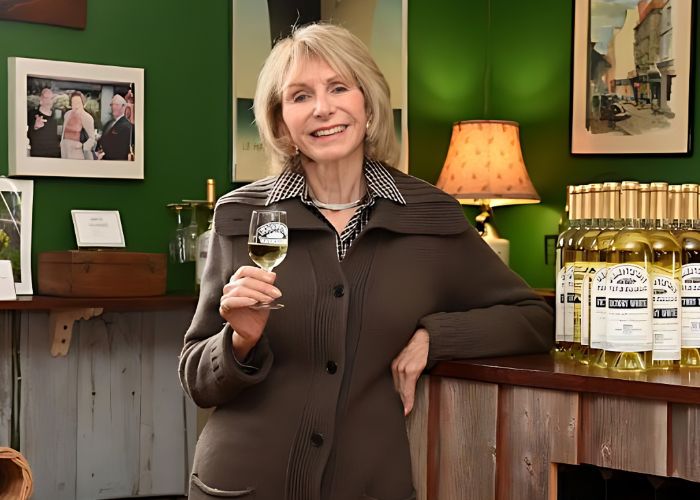Warehouse
Open from Jan 1st - July 10th 2026
Judging
Date
July 27, 2026
Winners
Announced
August 12, 2026

Sam Filler, as the Executive Director of the New York Wine and Grape Foundation (NYWGF), has spearheaded various initiatives to elevate the state's wines and grapes. From promoting sustainability to expanding global markets, Sam's leadership has been instrumental in advancing New York's wine industry. In this interview, Sam shares key achievements, programs, and future goals of NYWGF, shedding light on the foundation's role in shaping the industry's growth and success.
Prior to COVID, we hosted our 2019 annual trade tasting, the NY Drinks NY Grand Tasting, in partnership with the Rainbow Room, an iconic NYC restaurant at the top of Rockefeller Center that has spectacular views of the city. Our goal was to align the brand of New York Wines with a location in NYC that is an important part of the city’s hospitality industry and history. The Rainbow Room provided an excellent platform to showcase the best of New York Wines. We had record attendance from trade and media that day, and our participating wineries valued being showcased in the Rainbow Room.

Image: 2019 annual trade tasting, the NY Drinks NY Grand Tasting
In the present moment, our sustainability program represents an important initiative for the long-term identity of NY Wines. Many of our grape growers already adhere to sustainable vineyard management practices, and our program provides a means to recognize these practices with a formalized certification. Sustainable vineyard practices will be the baseline expectation for US wine consumers in the near future, so we want to make sure the NY industry is prepared to meet that market imperative.
I am most proud of our export program, which is funded through a grant from the USDA Foreign Agriculture Service. They have underwritten an export program for New York Wines for over 30 years. In 2023, we were able to attribute over $700,000 in sales to our international marketing efforts in our key markets of Canada, Western Europe, Japan, and South Asia. Our export program is an important vehicle for building the global brand identity of New York wines.
Early in my tenure, we were fortunate to be invited to participate in an initiative led by the California Sustainable Winegrowing Alliance (CSWA). They secured a grant from the California State Department of Agriculture to invest in market research, convene the major US wine grape growing to share best practices, and host an in-person summit in 2019 in Sonoma. CSWA’s market research showed that Millennial and Gen Z consumers would be willing to pay $3-5 more for a bottle of wine that can make a sustainability claim.
NYWGF’s participation in this initiative provided us with a boost in confidence to pursue a USDA NRCS Conservation Innovation Grant (CIG). Our participation in the CSWA project inspired John Ingle, owner of Heron Hill Winery and long-time Finger Lakes grape grower, to be a key financial donor to support the NYWGF sustainability program. The USDA grant and John’s support funded an update to our sustainability workbook called VineBalance, and it provided the seed funding to launch a pilot program in the Finger Lakes. We launched the program statewide in 2023, and we certified 49 vineyards.
My goal is for when a consumer walks into a wine shop and they are looking for a sustainably produced wine they think of a New York wine first. I want New York State wines to be synonymous with sustainability and sustainable vineyard practices. This will be the brand promise for New York wines.
At least 60% of all wine sales for New York wines are generated in the tasting room. This means that wine tourism is vital to the industry’s success. NYWGF provides support to regional marketing associations and wine trails to encourage visitation to the State’s wine regions. New York has been a leader in wine tourism since 1985 when the first US wine trail was formed on Cayuga Lake.
The distribution channel to on and off-premise retailers can be more challenging for wineries to see success, particularly in New York City, which is one of the most competitive wine markets in the world. Retailers and restaurants remain important partners in building the brand identity of New York wines, and NYWGF remains focused on improving access to this channel for New York wineries. While we improve the availability of New York wines in this channel, NYWGF works to provide the industry with educational resources to help them build out their DTC and e-commerce channels since these are more viable and immediate sales channels, and these channels can help build on relationships with consumers formed in the tasting room.
Given the importance of wine tourism and tasting room sales in New York, we intend to get more involved with consumer marketing. We started by updating our website with educational resources about New York and its grape-growing regions. Last year, we updated the New York Wine Reference guide, which includes guided videos on YouTube to enhance the learning experience. Over the next year, we plan to work with regional marketing and wine trail associations to create a more cohesive plan for marketing the wine tourism opportunities available in New York. This fits with our goal to build the brand identity of New York wines. We have had a lot of success over the past 10 years with trade and media, and we recognize that consumers are a key piece in the puzzle to drive more interest in New York Wines.
We know from the CSWA research that Millenials are asking about the provenance of the wines that they purchase particularly regarding grape growing and wine-making practices. Their interest in these factors can be addressed with certifications, which is why we launched our sustainability program. We have integrated sustainability as a key pillar in our promotions about New York wines. We have secured multiple USDA VAPG grants to conduct further market research on Millennials and Gen z willingness to purchase sustainable wines. This research informed the development of a trustmark that will be used by New York wineries on their bottles and positioning points for our marketing materials.

I think that this trend is concerning because Gen Z is the next generation of legal-age drinking consumers, and baby boomers, formerly the largest group, are beginning to decrease their purchasing and consumption of wine. But, in general, there is growing conscientiousness among consumers about their health and their food and beverage choices. We see this already as a buying decision factor in our Western European export markets among all age demographics. I’m an older Millennial (1982) and I have recently experienced some health issues myself, which has required me to be more conscientious about my wine consumption.
Given the market trends and my personal experience, I do think health-conscious consumers are here to stay. However, I think that there is still a place for wine at the table because wine consumption is driven by occasion and it shines when paired with food. Wine by the fact of its format, 750ml bottle, is meant to be enjoyed communally. It also remains an important beverage for celebratory occasions. Plus, emerging markets like Vietnam and South Korea have young middle-class consumers who are eager to learn more about wine.

Image: All-new ‘New York Wines’ and ‘Sustainable Winegrowing’ logos
We are definitely going through a difficult demographic transition as an industry, but there are emerging demographic groups who have been ignored by previous marketing efforts. These groups should now be invited to participate in the special place where wine can be served at the table and bring people together.
NYWGF’s founder, Jim Trezise, uses this mantra to describe the grape and wine industry, “Diversity is our Strength. Unity is our Power.” NYWGF was formed in 1985 by a grassroots effort of grape growers, farm wineries, and large processors in New York State. We are a literal manifestation of a community that came together, put aside its self-interests, and created something for the greater good of the industry and the state.
When we rebranded in 2019 as “Boldly, NY,” we adopted a brand manifesto titled, “Band of Outsiders,”:
First, they ignored us, then dismissed us, then called us crazy
But we didn’t ask for approval
We are the outsiders in an industry of old-world institutions
We were never supposed to make it big
We could easily move and grow in perfect conditions, but we didn’t.
We leaned into adversity and came together as a family to make something out of nothing.
The game is changing and we’re staking a spot at the front of the pack.
Instead of following centuries of tradition, rituals, or rules
We are redefining quality, tastes, and experiences
Enjoy it how you’d like, we won’t judge.
Our future is not in algorithms.
It’s about our customers, our growers, and our members
It’s for the people, by the people
Our collaborative ethos is irreverent in and of itself.
We’re an intrepid band of outsiders and we’re in this together.
A family and we believe in what we do.

Image: Phyllis Feder
The Phyllis Feder Unity Award was named after our past Board Chair Phyllis Feder. She owned Clinton Vineyards in the Hudson Valley and served as Board Chair during a tumultuous time for NYWGF. The industry experienced a growth spurt in many of its regions. These regions wanted a greater voice within the organization. Phyllis leaned into the industry’s spirit of Unity to help NYWGF be more inclusive of the emergent regions while continuing to promote the reputation for the quality of the State’s established regions.
NYWGF continues to recognize Phyllis Feder because she serves as an example of the importance of collaboration and inclusivity.
The vineyard survey is important to the New York Wine & Grape Foundation’s mission because we serve as the industry’s primary economic development and promotion entity. Current and accurate vineyard data supports our research funding priorities, which are supported by State and private sector funding. The data supports our initiatives to promote the industry to trade, media, and consumers across the world. Survey data on production can provide benchmark figures required to compare New York winegrowing regions, both internally and with key domestic and international winegrowing regions.
The USDA National Agricultural Statistics Service (NASS) completed the last comprehensive vineyard survey in 2011. The wine industry has more than doubled in size since 2011, two new AVAs were established for the Champlain Valley and Upper Hudson, while the juice grape industry experienced a period of contraction and declining consumer demand. Having current and accurate data on the economic impact of the wine and grape industry is crucial for legislative advocacy, business decisions, research priorities, marketing strategies, and demonstrating the industry's size and influence. These reports provide essential information for policymakers to allocate funding and support initiatives that promote the growth and sustainability of the industry, ultimately benefiting.
The survey remains open until May 1, 2024, for grape growers to submit their data. We want to achieve a 50% response rate this year and improve to 70% in 2025. We also partnered with Deep Planet to conduct a satellite scan of known vineyard areas and produce a foundation geodata set of the current vineyard locations, acreage, and red versus white varieties in New York State, across the 11 AVAs and other known winegrower areas using Deep Planets’ proprietary Vineyard Detection algorithm.
B.E.V. NY is the preeminent conference for New York’s grape and wine industry. The conference is organized by Cornell University’s College of Agriculture and Life Sciences and Cornell Cooperative Extension’s Finger Lakes Grape Program. The conference presents the latest and cutting-edge research on business, enology, and viticulture (B.E.V.). New York is a challenging environment to grow grapes, transform the grapes into wine, and then sell the wine. B.E.V. NY provides the industry with the latest tools to elevate the quality of their grape growing, winemaking, and selling practices. More about this year’s program can be viewed here: https://www.bevny.org
STARTING to run out of gas with all your great questions! The export program is important because it helps us build the global brand identity of New York Wines and it allows us to directly support over 30 wineries to get their wines distributed in international markets. Here are links to our export newsletter that highlights our activities from all our target markets:
https://mailchi.mp/nywgf/welcome-to-the-export-program-5359723?e=b83d0aeef2
https://mailchi.mp/nywgf/welcome-to-the-export-program-5359491?e=b83d0aeef2
https://mailchi.mp/nywgf/the-press-deck-5359459?e=b83d0aeef2
NYWGF was created in 1985, in part, to help establish a funding channel for research in the areas of viticulture, enology, and “best practices” in wine marketing and business development. For 35 years, NYWGF has annually distributed funds to projects that provide the New York State wine and grape industry with short-term solutions and long-term strategic directions. NYWGF has sponsored an ambitious and comprehensive program in close coordination with the industry and academia. NYWGF’s annual research budget is normally between $450,000-$600,000 to support dozens of individual projects, mostly conducted by Cornell University’s New York State Agricultural Experiment Station in Geneva. Explore previously funded projects.
We want to create a financially sustainable organization because we believe the organization and industry serve an important economic development function for New York State, especially in rural communities. Our annual budget is around $2.5 million, and we know that several leading European wine-producing countries spend over $2 million per year in New York City alone to promote their wines. Despite our industry’s proximity to such an important wine market, it isn't easy to compete with better-resourced regions as we try to gain market share and shelf space in New York City. We are fortunate that the State of New York has invested in NYWGF and the industry for almost 40 years, and we intend to leverage the State’s long-term investment to continue to support the industry’s growth in key markets and positively impact New York’s economy.
[[relatedPurchasesItems-55]]
As the wine industry evolves, the New York Wine and Grape Foundation, under Samuel's leadership, remains committed to enhancing the reputation and reach of New York wines. Through innovative programs, sustainable practices, and strategic partnerships, NYWGF continues to be a driving force in promoting the world-class wines of New York State. Samuel's vision and dedication underscore the foundation's ongoing impact on the industry, ensuring a vibrant future for New York wines on the global stage.
In conversation with Malvika Patel, Editor and VP, Beverage Trade Network
Grow your wines in the off-premise channels of the USA. The Early Bird submission deadline is February 20, 2026, and the domestic submission deadline is June 30, 2026. Here is how to enter.